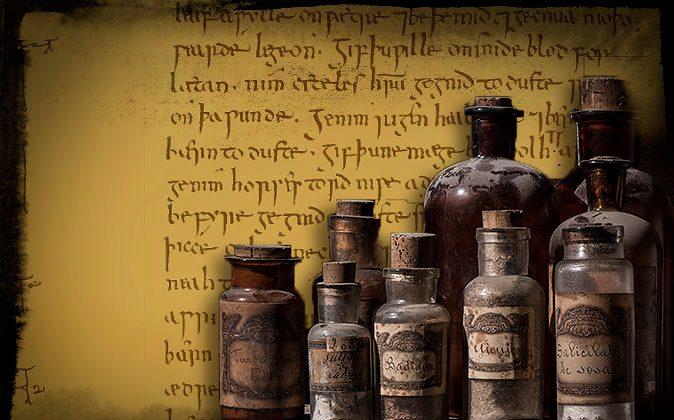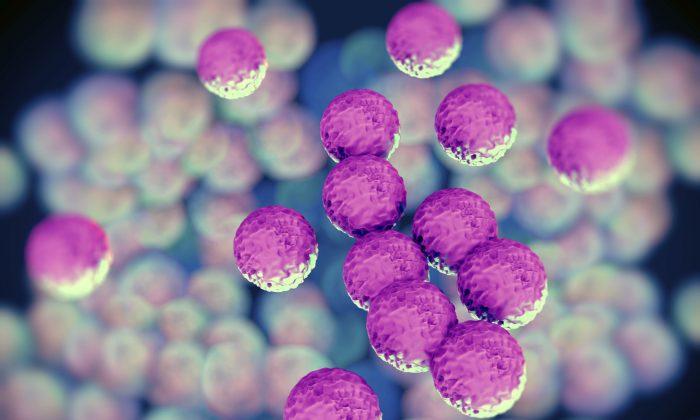Researchers recreated a 10th century potion for eye infections from Bald’s Leechbook, an Old English volume in the British Library, to see if it really works as an antibacterial remedy.
Their findings show that Bald’s eye salve kills up to 90 percent of Methicillin-resistant Staphylococcus aureus (MRSA) bacteria in in vivo wound biopsies from mouse models.
Christina Lee, associate professor in Viking studies and member of University of Nottingham’s Institute for Medieval Research, had the idea to test the ancient remedy. Lee translated the recipe from a transcript of the original Old English manuscript.
Following the Recipe
The recipe calls for two species of Allium (garlic and onion or leek), wine, and oxgall (bile from a cow’s stomach). It describes a very specific method of making the topical solution, including the use of a brass vessel to brew it in, straining to purify it, and an instruction to leave the mixture for nine days before use.
“We thought that Bald’s eye salve might show a small amount of antibiotic activity, because each of the ingredients has been shown by other researchers to have some effect on bacteria in the lab—copper and bile salts can kill bacteria, and the garlic family of plants make chemicals that interfere with the bacteria’s ability to damage infected tissues,” said microbiologist Freya Harrison.
“But we were absolutely blown away by just how effective the combination of ingredients was. We tested it in difficult conditions, too. We let our artificial ‘infections’ grow into dense, mature populations called biofilms, where the individual cells bunch together and make a sticky coating that makes it hard for antibiotics to reach them.
“But unlike many modern antibiotics, Bald’s eye salve has the power to breach these defenses.”

Artificial and Real Wounds
Researchers tested the remedy on cultures of the commonly found and hard to treat bacteria, Staphylococcus aureus, in both synthetic wounds and in infected wounds in mice.
The team made artificial wound infections by growing bacteria in plugs of collagen and then exposed them to each of the individual ingredients or the full recipe.
None of the individual ingredients alone had any measurable effect, but when combined according to the recipe the Staphylococcus populations were almost totally obliterated: About one bacterial cell in a thousand survived.
‘Genuinely Amazed’
The team then went on to see what happened if they diluted the eye salve—as it is hard to know just how much of the medicine bacteria would be exposed to when applied to a real infection.
They found that when the medicine is too dilute to kill Staphylococcus aureus, it interfered with bacterial cell-cell communication (quorum sensing). This is a key finding, because bacteria have to talk to each other to switch on the genes that allow them to damage infected tissues.
Many microbiologists think that blocking this behavior could be an alternative way of treating infection.
“When we built this recipe in the lab I didn’t really expect it to actually do anything. When we found that it could actually disrupt and kill cells in S. aureus biofilms, I was genuinely amazed,” says collaborator Steve Diggle.
Kendra Rumbaugh carried out in vivo testing of the Bald’s remedy on MRSA infected skin wounds in mice at Texas Tech University.
“We know that MRSA infected wounds are exceptionally difficult to treat in people and in mouse models. We have not tested a single antibiotic or experimental therapeutic that is completely effective; however, this ‘ancient remedy’ performed as good if not better than the conventional antibiotics we used,” says Rumbaugh.
“The rise of antibiotic resistance in pathogenic bacteria and the lack of new antimicrobials in the developmental pipeline are key challenges for human health,” adds Harrison. “There is a pressing need to develop new strategies against pathogens because the cost of developing new antibiotics is high and eventual resistance is likely.”
Harrison will present the findings at the Annual Conference of the Society for General Microbiology this week in Birmingham.
The AncientBiotics team at Nottingham is seeking more funding to extend the project.
The University of Nottingham is committed to the principles of the 3Rs of reduction, refinement, and replacement. For each project it ensures, as far as is reasonably practicable, that no alternative to the use of animals is possible, that the number of animals used is minimized, and that procedures, care routines, and husbandry are refined to maximize welfare. The University is a signatory member of the U.K. Concordat on Openness on Animal Research.
Republished from Futurity.org under Creative Commons License 4.0.
*Image of “bottles” via Jose Miguel Barcelo/iStock/Thinkstock




Friends Read Free